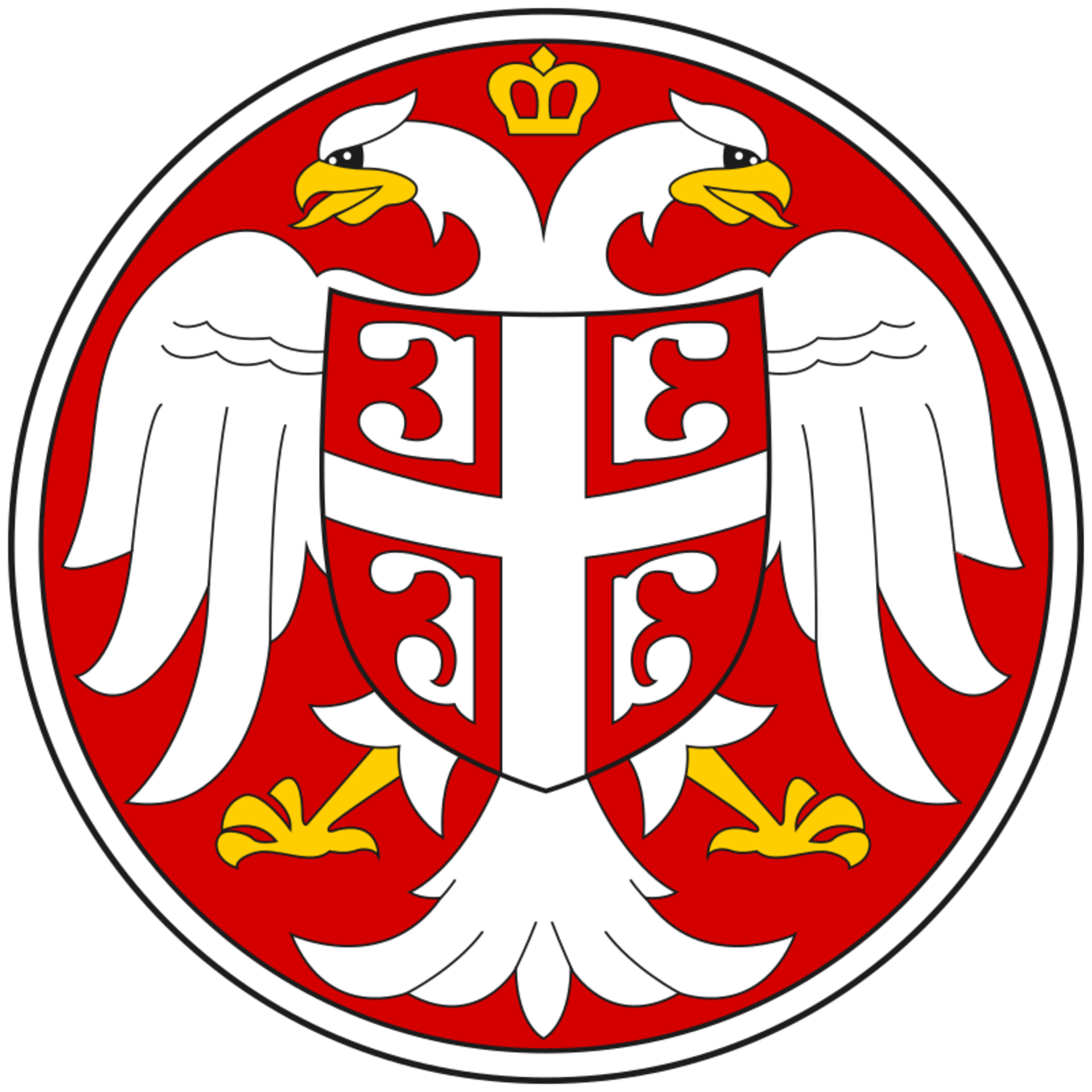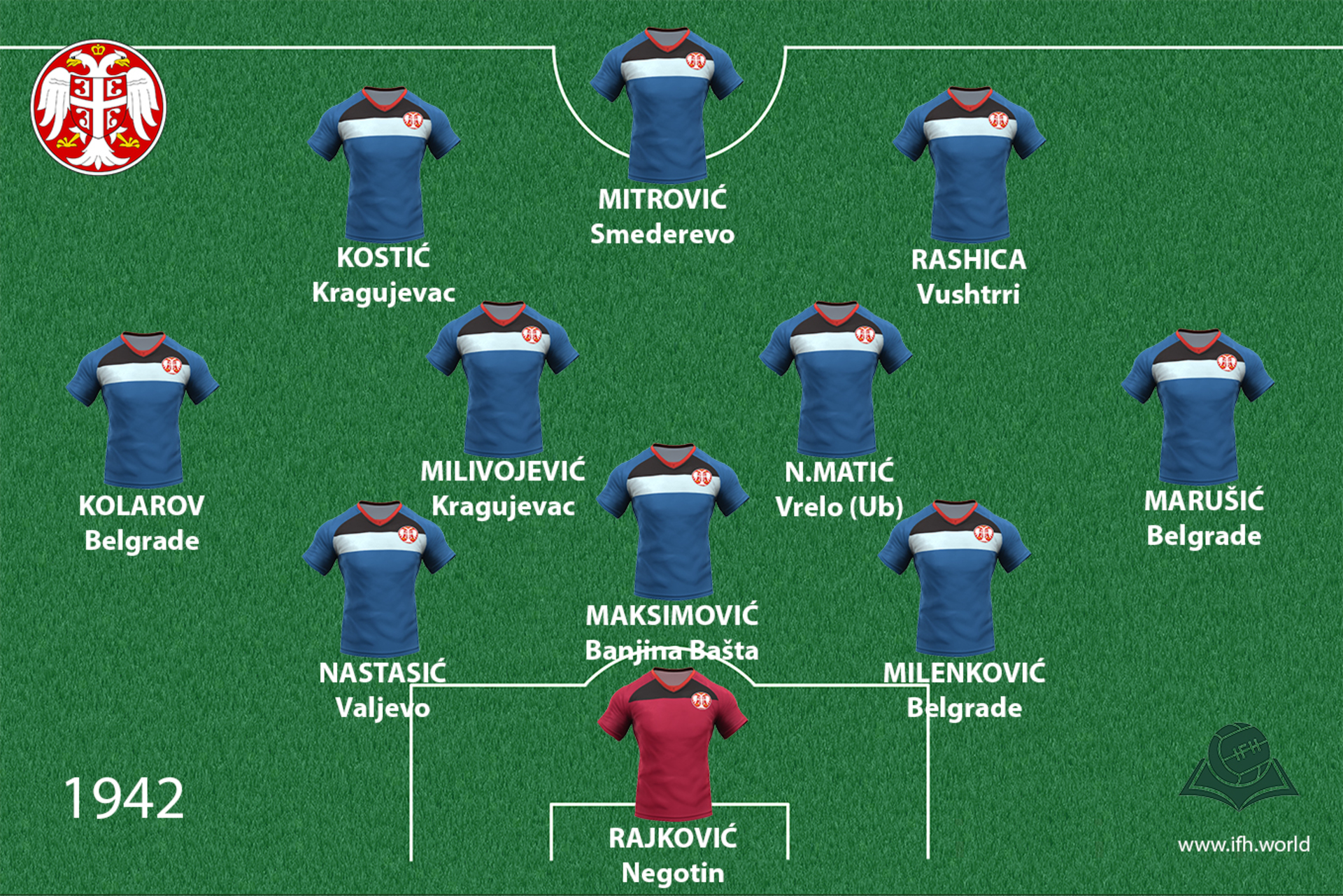The Territory of the Military Commander in Serbia
After the bombing of Belgrade in April 1941 and the fall of the Kingdom of Yugoslavia, the Germans declared the so-called " The Territory of the Military Commander in Serbia', colloquially known as "Nedic's Srbija" by the name of its Prime Minister.

Coat of arms
Shirt
| Position | First name | Last name | Mjesto rođenja | Like | Dislike | |
|---|---|---|---|---|---|---|
| GK | Predrag | RAJKOVIĆ | Negotin |
27 |
4 |
|
| DC | Matija | NASTASIĆ | Valjevo |
63 |
6 |
|
| DC | Nikola | MILENKOVIĆ | Belgrade |
18 |
7 |
|
| DC | Uroš | SPAJIĆ | Belgrade |
4 |
1 |
|
| DRLC | Nenad | TOMOVIĆ | Kragujevac |
22 |
6 |
|
| DRL/MR | Adam | MARUŠIĆ | Belgrade |
6 |
1 |
|
| DR/MR | Dušan | BASTA | Belgrade |
4 |
1 |
|
| DL/ML | Aleksandar | KOLAROV | Belgrade |
45 |
13 |
|
| DL/ML | Ivan | OBRADOVIĆ | Obrenovac |
15 |
4 |
|
| DMC | Luka | MILIVOJEVIĆ | Kragujevac |
30 |
9 |
|
| DMC | Nemanja | MATIĆ | Vrelo |
60 |
10 |
|
| MC | Nemanja | GUDELJ | Belgrade |
2 |
0 |
|
| MC | Nikola | MAKSIMOVIĆ | Belgrade |
27 |
14 |
|
| MC | Zlatko | JUNUZOVIĆ | Loznica |
11 |
9 |
|
| AMRLC | Milot | RASHICA | Vushtrri |
4 |
11 |
|
| AMRL | Andrija | ŽIVKOVIĆ | Niš |
18 |
3 |
|
| AMRL | Filip | KOSTIĆ | Kragujevac |
29 |
9 |
|
| FC | Aleksandar | MITROVIĆ | Smederevo |
31 |
10 |
The head of the German military commander in Serbia consisted of two administrations: one was for military, and the other for civil issues. The latter was practically a civilian governor of Serbia nominally led by colaborationist government of General Milan Nedić, set up in August 1941., who can't do anything without German approval. [1] General Milan Nedić was the hero of the Balkan wars, First World War and the former Army and Navy Minister of the Kingdom of Yugoslavia who was removed from that duty in 1939 because of his great sympathy to the power of the German military machine. He was a conservative, a strong anti-communist, anti-Yugoslavist, and a supporter of the idea of Great Serbia. [2] He managed to reduce the number of Serbs in German repression and worried about Serbian refugees from ISC (NDH). [3] He often referred to "brothers Serbs and sisters Serbs, Serbian youth, peasants Serb ..." that "Aryan Serbian nation", which, of course, in some wider frameworks in Third Reich was far from a privileged nation. [4]
Nedić demanded from the Germans a number of conditions, before all a greater autonomy for Serbia. But only demands in which Germans were interested have been accepted: the formation of police-military forces serving the Germans as extraordinary aid in hunting Jews and fighting communist partisans, and the flag, coat of arms and anthem, which should give the population an appearance of independence of Serbia and of "statehood", and contribute to strengthening the authority of Nedić's government. [5]
Although the Holocaust was entirely under the authority of the Germana, all their orders were executed through a series of offices signed by Nedić's government, which legitimized the Holocaust and the process of degrading Jews and Roma as second-line citizens.[6] Serbian military and police forces have also given an independent "contribution" to the Jews for their deprivation of liberty, and then handing them over to the Nazi occupier "for further proceedings''. [7]
Parallel with the presence of the German forces and Serbian military and police formation, and their domestic allies such as paramilitary forces like the Serbian Volunteer Corps, [8] in the area of Nedić's Serbia - which was territorially stretched across pre-war southern and central Serbia with Belgrade, the northern part of Kosovo and Banat - a large number Serbs approached various Chetnik groups and the Communist Partisan Movement. So during 1941-44. in Serbia, a civil war lasted, where everyone in each phase worked and cooperated, especially in the joint struggle against the communist forces.
The Chetnik movement was declared the Yugoslav army in the countryside at the beginning of the war by the refugee Yugoslavian royal government. It was formally led by Draža Mihajlović, but since Montenegrin, Herzegovinian, Bosnian, Dalmatian-Lika and Slovenian Chetniks existed, the movement as such did not have a unified organization, and many Chetniks were transformed into the true county masters, [9] establishing different forms of cooperation with Nedić, the Italians, the Germans even with the forces of ISC (NDH).The movement officially propagated for the continuity of Yugoslavia, with the primacy of Serbia, but since it was almost entirely unilateral nationally oriented as such could not have been a unifying factor in the territory of the next Yugoslavia. [10] The movement was simply a continuation of the old hajduks patriarchal population, and since its ideology was based on the tribal mentality it had to be forced into violence against non-Serbs or members of other "tribes" as such. [11]
- [1] Zlatoje Martinov, NDH I NEDIĆEVA SRBIJA: Sličnosti i razlike, SAVEZ ANTIFAŠISTA SRBIJE, ORION|ART Beograd, 2018., 61
- [2]Zlatoje Martinov, NDH I NEDIĆEVA SRBIJA: Sličnosti i razlike, SAVEZ ANTIFAŠISTA SRBIJE, ORION|ART Beograd, 2018., 128
- [3] Branislav Grković, "Neobavešteni, a delimo se oko Nedića"
- https://www.b92.net/info/intervju/index.php?yyyy=2015&nav_id=1072656
- [4] Branislav Grković, "Neobavešteni, a delimo se oko Nedića"
- https://www.b92.net/info/intervju/index.php?yyyy=2015&nav_id=1072656
- [5] Zlatoje Martinov, NDH I NEDIĆEVA SRBIJA: Sličnosti i razlike, SAVEZ ANTIFAŠISTA SRBIJE, ORION|ART Beograd, 2018.,74
- [6] Branislav Grković, "Neobavešteni, a delimo se oko Nedića"
- https://www.b92.net/info/intervju/index.php?yyyy=2015&nav_id=1072656
- [7] Zlatoje Martinov, NDH I NEDIĆEVA SRBIJA: Sličnosti i razlike, SAVEZ ANTIFAŠISTA SRBIJE, ORION|ART Beograd, 2018.,91
- [8] Darko DUKOVSKI, Povijest Srednje i Jugoistočne Europe 19. i 20. stoljeća , sv.II., Zagreb, 2005., 194
- [9] Sabrina Petra RAMET, Tri Jugoslavije : izgradnja države i izazov legitimacije : 1918.- 2005., Zagreb, 2009., 199
- [10] Zdravko DIZDAR, '' Četnički pokret na području Hrvatske i Bosne i Hercegovine (1941.-1945'', Nezavisna Država Hrvatska 1941.-1945. (ur. Sabrina P. Ramet), Zagreb, 2009.,66
- [11] Ivo RENDIĆ MIOČEVIĆ, Zlo velike jetre, Split, 1996., 334
Sources
- Zdravko DIZDAR, '' Četnički pokret na području Hrvatske i Bosne i Hercegovine (1941.-1945'', Nezavisna Država Hrvatska 1941.-1945. (ur. Sabrina P. Ramet), Zagreb, 2009.
- Darko DUKOVSKI, Povijest Srednje i Jugoistočne Europe 19. i 20. stoljeća , sv.II., Zagreb, 2005.
- Zlatoje Martinov, NDH I NEDIĆEVA SRBIJA: Sličnosti i razlike, SAVEZ ANTIFAŠISTA SRBIJE, ORION|ART Beograd, 2018.
- Sabrina Petra RAMET, Tri Jugoslavije : izgradnja države i izazov legitimacije : 1918.- 2005., Zagreb, 2009.
- Ivo RENDIĆ MIOČEVIĆ, Zlo velike jetre, Split, 1996., 334
- Aleksandar Stojanović, ''SMRT MILANA NEDIĆA: Izdajnik ili tragičar?''
- https://www.ekspres.net/istorija/smrt-milana-nedica-izdajnik-ili-tragicar
- Branislav Grković, "Neobavešteni, a delimo se oko Nedića"
- https://www.b92.net/info/intervju/index.php?yyyy=2015&nav_id=1072656
